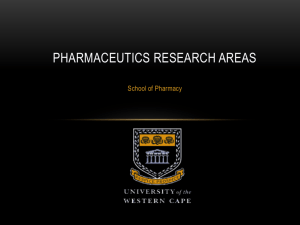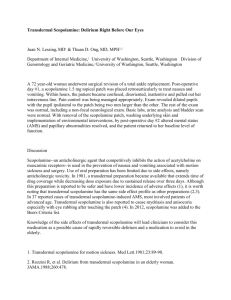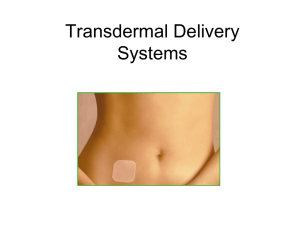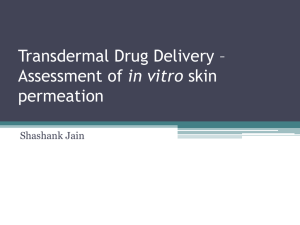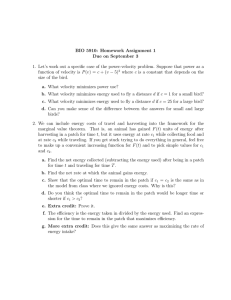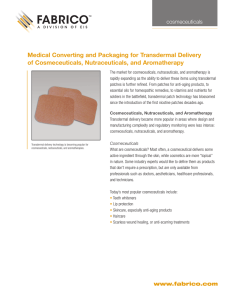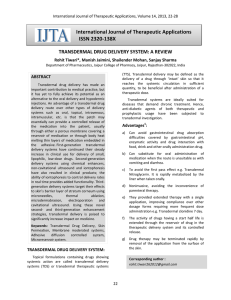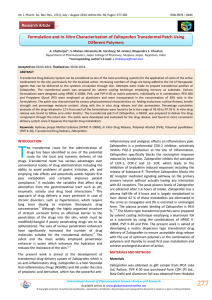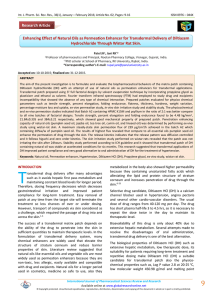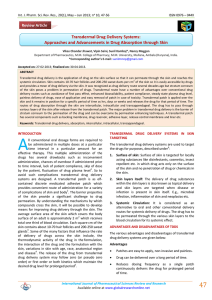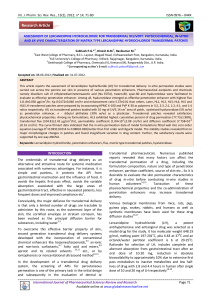Document 13308813
advertisement
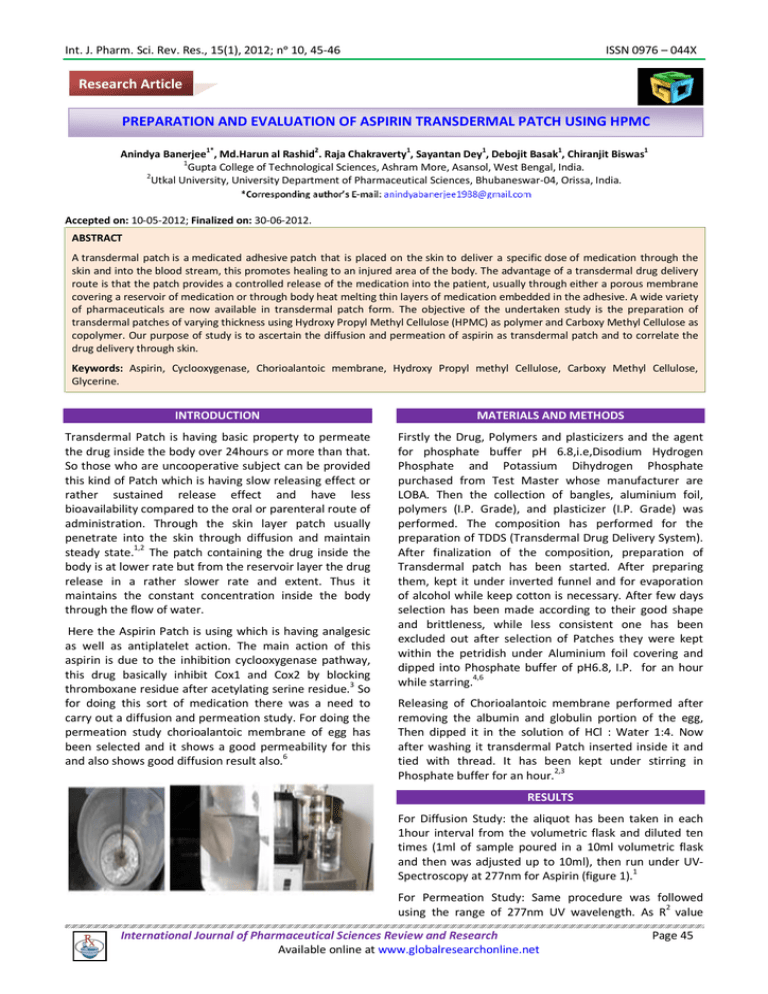
Int. J. Pharm. Sci. Rev. Res., 15(1), 2012; nᵒ 10, 45-46 ISSN 0976 – 044X Research Article PREPARATION AND EVALUATION OF ASPIRIN TRANSDERMAL PATCH USING HPMC 1* 2 1 1 1 1 Anindya Banerjee , Md.Harun al Rashid . Raja Chakraverty , Sayantan Dey , Debojit Basak , Chiranjit Biswas 1 Gupta College of Technological Sciences, Ashram More, Asansol, West Bengal, India. 2 Utkal University, University Department of Pharmaceutical Sciences, Bhubaneswar-04, Orissa, India. Accepted on: 10-05-2012; Finalized on: 30-06-2012. ABSTRACT A transdermal patch is a medicated adhesive patch that is placed on the skin to deliver a specific dose of medication through the skin and into the blood stream, this promotes healing to an injured area of the body. The advantage of a transdermal drug delivery route is that the patch provides a controlled release of the medication into the patient, usually through either a porous membrane covering a reservoir of medication or through body heat melting thin layers of medication embedded in the adhesive. A wide variety of pharmaceuticals are now available in transdermal patch form. The objective of the undertaken study is the preparation of transdermal patches of varying thickness using Hydroxy Propyl Methyl Cellulose (HPMC) as polymer and Carboxy Methyl Cellulose as copolymer. Our purpose of study is to ascertain the diffusion and permeation of aspirin as transdermal patch and to correlate the drug delivery through skin. Keywords: Aspirin, Cyclooxygenase, Chorioalantoic membrane, Hydroxy Propyl methyl Cellulose, Carboxy Methyl Cellulose, Glycerine. INTRODUCTION MATERIALS AND METHODS Transdermal Patch is having basic property to permeate the drug inside the body over 24hours or more than that. So those who are uncooperative subject can be provided this kind of Patch which is having slow releasing effect or rather sustained release effect and have less bioavailability compared to the oral or parenteral route of administration. Through the skin layer patch usually penetrate into the skin through diffusion and maintain steady state.1,2 The patch containing the drug inside the body is at lower rate but from the reservoir layer the drug release in a rather slower rate and extent. Thus it maintains the constant concentration inside the body through the flow of water. Firstly the Drug, Polymers and plasticizers and the agent for phosphate buffer pH 6.8,i.e,Disodium Hydrogen Phosphate and Potassium Dihydrogen Phosphate purchased from Test Master whose manufacturer are LOBA. Then the collection of bangles, aluminium foil, polymers (I.P. Grade), and plasticizer (I.P. Grade) was performed. The composition has performed for the preparation of TDDS (Transdermal Drug Delivery System). After finalization of the composition, preparation of Transdermal patch has been started. After preparing them, kept it under inverted funnel and for evaporation of alcohol while keep cotton is necessary. After few days selection has been made according to their good shape and brittleness, while less consistent one has been excluded out after selection of Patches they were kept within the petridish under Aluminium foil covering and dipped into Phosphate buffer of pH6.8, I.P. for an hour while starring.4,6 Here the Aspirin Patch is using which is having analgesic as well as antiplatelet action. The main action of this aspirin is due to the inhibition cyclooxygenase pathway, this drug basically inhibit Cox1 and Cox2 by blocking 3 thromboxane residue after acetylating serine residue. So for doing this sort of medication there was a need to carry out a diffusion and permeation study. For doing the permeation study chorioalantoic membrane of egg has been selected and it shows a good permeability for this and also shows good diffusion result also.6 Releasing of Chorioalantoic membrane performed after removing the albumin and globulin portion of the egg, Then dipped it in the solution of HCl : Water 1:4. Now after washing it transdermal Patch inserted inside it and tied with thread. It has been kept under stirring in Phosphate buffer for an hour.2,3 RESULTS For Diffusion Study: the aliquot has been taken in each 1hour interval from the volumetric flask and diluted ten times (1ml of sample poured in a 10ml volumetric flask and then was adjusted up to 10ml), then run under UVSpectroscopy at 277nm for Aspirin (figure 1).1 For Permeation Study: Same procedure was followed using the range of 277nm UV wavelength. As R2 value International Journal of Pharmaceutical Sciences Review and Research Available online at www.globalresearchonline.net Page 45 Int. J. Pharm. Sci. Rev. Res., 15(1), 2012; nᵒ 10, 45-46 tends to 1 in both diffusion and permeation study, then it was assured and can be assumed that diffusion inside the body and even the permeation rate will be in the steady state range throughout the day. (figures 2 & 3, tables 1 & 2). ISSN 0976 – 044X through the different layers of the skin in order to reach to the systemic circulation. The drugs need to cross the layer of skin and the drug will bind to the particular target receptor and will elicit pharmacological action. In the blood stream drug will release in ascertains rate while the drug reservoir release the drug more slower to maintain steady state.8 CONCLUSION Figure 1: Graph of absorbance vs concentration for Aspirin Table 1: Diffusion curve Time (hours) Concentration (mg/ml) 1 24.6 2 29.1 3 30 Aim of the study was totally for the patients, those who are non-compliant they get biased or feel embarrassed while taking oral route of drug. Here the drug aspirin was under consideration because the bioavailability of the drug in this kind of delivery system is lower than that of oral. As because the drug is used as an Anti platelet agent or as NSAID then it need to continue for long time, prolong use of Aspirin may cause some kind of adverse effect like Reye’s syndrome while taken orally. So to overcome this kind of problem and to ascertain the complete relief from the disease this kind of delivery system was performed. REFERENCES 1. Saroha K,Yadav B,Sharma B., Transdermal patch: a discrete dosage form. Int J Curr Pharm Res, 3(3), 2011, 98108. 2. D.R. Krishna, A.G. Srinivas, A. Srinivas. Transdermal aspirin:Influence of platelet aggregation and lipid peroxides. Ind. J. Pharm. Sci., 63, 2000, 200-204. 3. H.O.Ammar, M. Ghorab, S. El-Nahhas. Design of a transdermal delivery system for aspirin as an antithrombic drug. Int. J. Pharm, 327, 2006, 81-88. 4. B McAdam, R M Keimowitz, M Maher. Transdermal modification of platelet function: an aspirin patch system results in marked suppression of platelet cyclooxygenase. J Pharmacol Exp Ther, 277, May 1996, 559-564. 5. L.H. Block. Mediated Application. In Remington, A. R. Gennaro, Ed., 2006, 942-949. 6. Areeg A. S., Naseem A. C., Kohli K, Pillai K, Rahman Z. Effect of Transdermally Delivered Aspirin on Blood Coagulation Parameters. Am. J. Biomed. Sci. 2(2), 2010, 129-141. 7. H. O. Ammar, M. Ghorab, S. A. El-Nahhas, R. Kamel. Evaluation of chemical penetration enhancers for transdermal delivery of aspirin. Asian Journal of Pharmaceutical Sciences, 2(3), 2007, 96-105. 8. KD Tripathi, Essentials of medical pharmacology, 5 , JAYPEE, 2003, 08. Figure 2: Permeation curve PERMIATION GRAPH y = 0.1214x + 23.903 R2 = 0.9897 50 180, 45.33 CONCENTRATION(ug/ml) 45 40 120, 39.33 35 60, 30.76 30 Series1 Linear (Series1) 25 20 15 10 5 0 0 50 100 150 200 TIM E (min) Table 2: For permeation Time (hrs) Concentration (mg/ml) 1 30.76 2 39.33 3 45.33 DISCUSSION The ultimate aim of the transdermal patch is to release its medicament into the systemic circulation. From the blood stream it will go into the site of action and will elicit pharmacological action. In order to enter into the systemic circulation, the drug molecule after being diffused throughout the cell membrane has to permeate th ********************* International Journal of Pharmaceutical Sciences Review and Research Available online at www.globalresearchonline.net Page 46


